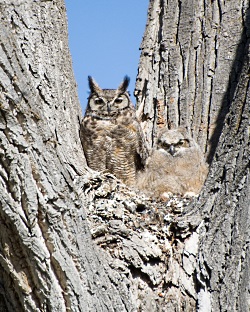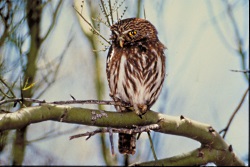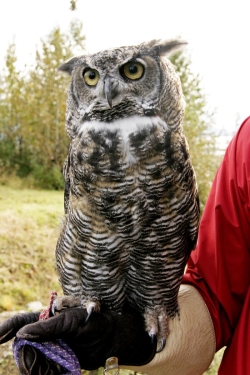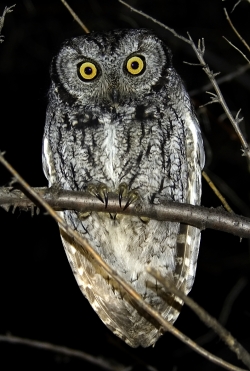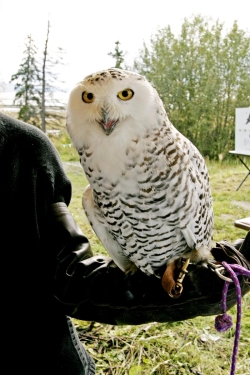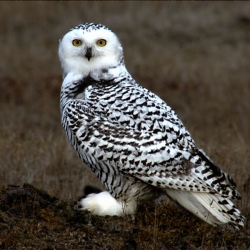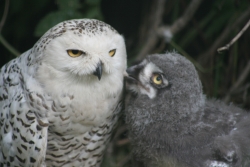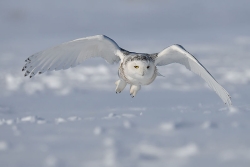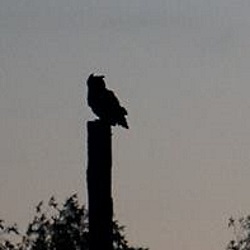
perched at dusk,
hunting for its young
Photo Courtesy & Copyright 2009
Mark Larese-Casanova
Late summer is the time of change when the rich nature born of spring matures and enters the next stage of its life. Streams and wetlands may dry up in the heat. Wildflowers wither and produce seeds to ensure a plant’s survival into the future. And, young wildlife leave their place of birth to strike out on their own.
Prior to fledging, young red-tailed hawks build flight muscles by hopping and flapping their wings in the nest. Once they are strong enough, the young red-tailed hawks make excursions from the nest, often soaring together, calling to each other while they fly. This time of year, red-tailed hawk fledglings can still be seen perched atop telephone poles, even in the middle of town, calling to their parents and begging for food. As a bird that usually spends the entire year in Utah, the red-tailed hawk must prepare for its solitary, cold winter ahead.
The calls of great horned owls often echo through the late summer nights. The adult owl soars through an open field while the fledgling owlet is perched nearby, calling for food. The parent responds, and faithfully catches a mouse to feeds its young. Aside from their echoing calls, this all happens quietly and almost invisibly. A lucky observer might spy an owlet and its parent at dusk, but the great horned owl’s soft feathers ensure that their flight is silent, even when just overhead.
Some young reptiles disperse in summer, too, just like birds. Tiny garter snakes, no larger in length or width than a pencil, can often be found slithering across meadows or even lawns. Rather than laying eggs in a nest, the female garter snake retains the eggs in her body until they are ready to hatch. While young garter snakes receive no parental care after birth, the mother hedges her bets by producing upwards of twenty young in the second half of each summer. At least two need to survive over the mother’s life to maintain a stable population.
Fledging and dispersal in late summer is a time of great risk, though. It’s very common in Utah to see road kill of young marmots, skunks, raccoons, and mink, among others. Many inexperienced young animals are also taken by predators. In nature, survival to adulthood is relatively uncommon, so the great investment of the parents is essential for a species to survive.
For Wild About Utah, I’m Mark Larese-Casanova.
Credits:
Images: Courtesy and copyright Mark Larese-Casanova
Text: Mark Larese-Casanova, Utah Master Naturalist Program at Utah State University Extension.
Additional Reading:
Danilson, C.D. Post-Fledging Ecology of Great Horned Owls in South Central Saskatchewan. Master’s Thesis. https://scholarworks.boisestate.edu/td/505/
Great Horned Owls. All About Birds. Cornell Lab of Ornithology. https://www.birds.cornell.edu/AllAboutBirds/owlp/ghowl
Red-tailed hawk. Hawkwatch International. https://www.hawkwatch.org/blog/item/130-red-tailed-hawk-buteo-jamaicensis
Great Horned Owl, Utah Division of Wildlife Resources, Department of Natural Resources, State of Utah, https://fieldguide.wildlife.utah.gov/?species=bubo%20virginianus
Red-tailed Hawk – Buteo jamaicensis. Utah Division of Wildlife Resources, Department of Natural Resources, State of Utah, https://fieldguide.wildlife.utah.gov/?species=buteo%20jamaicensis
Common Gartersnake – Thamnophis sirtalis. Utah Division of Wildlife Resources, Department of Natural Resources, State of Utah, https://fieldguide.wildlife.utah.gov/?species=thamnophis%20sirtalis
Black-necked Gartersnake – Thamnophis cyrtopsis. Utah Division of Wildlife Resources, Department of Natural Resources, State of Utah, https://fieldguide.wildlife.utah.gov/?species=thamnophis%20cyrtopsis
Terrestrial Gartersnake – Thamnophis elegans. Utah Division of Wildlife Resources, Department of Natural Resources, State of Utah, https://fieldguide.wildlife.utah.gov/?species=thamnophis%20elegans
Thamnophis elegans: Western Terrestrial Garter Snake. Animal Diversity Web. https://animaldiversity.ummz.umich.edu/accounts/Thamnophis_elegans/

